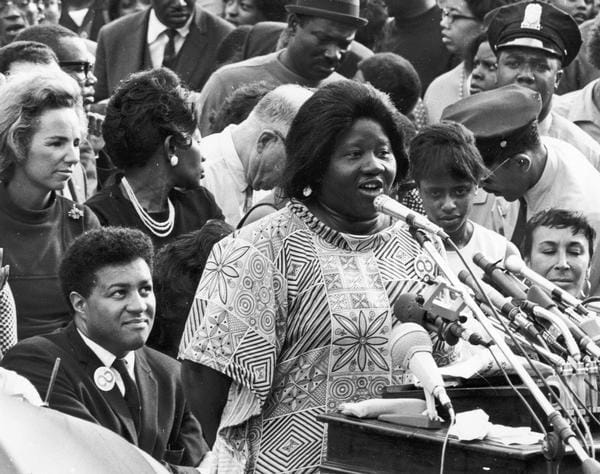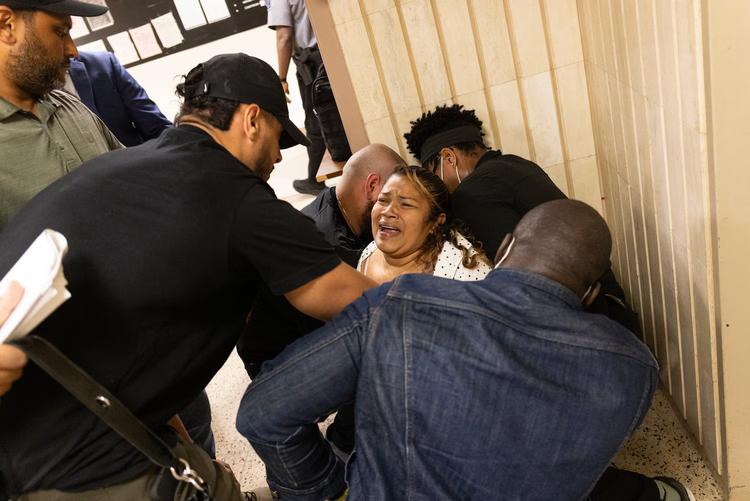Organizing like Johnnie Tillmon

Hello, and welcome to This Kairos Moment–a publication keeping up with powerful organizing around the country, aimed at answering the questions “what works?” and “what can we do?” amidst this political crisis.
Our team has been engaged in all sorts of organizing across the United States for the past forty years, with a focus on anti-poverty work. This means that, together, we’ve witnessed and been a part of hundreds of campaigns, organizations, strategies, actions, protests, and more. Some have been wildly successful, while others haven’t. Through each stop on our individual journeys, we have taken stock of the aspects that have led to those successes and those that have been sticking points.
Our nation is in a moment of crisis, a Kairos moment (learn more on our About page). As the federal government consolidates power and attempts to wrest democracy from the hands of the masses, we know that now is the time for bold, unsettling action that reimagines our national priorities away from war, oppression, and austerity towards peace, liberty, and plenty. As students of the robust organizing history in the United States, and veteran organizers ourselves, our goal is not to prescribe, but to educate from the rich lineages that bore us.
Our first issue (which you’re about a fifth of the way through–thanks by the way) is about one organizing model: The Johnnie Tillmon Model of Organizing–named for the indomitable welfare rights organizer. Today, we’ll introduce you to Johnnie Tillmon, explain her organizing model, and give you a couple of examples of the model in action. So buckle up, read on, and consider subscribing to This Kairos Moment.
Note: Much of the following has been adapted from the recent book You Only Get What You’re Organized To Take (Beacon Press, 2025), written by two members of our team, Rev. Dr. Liz Theoharis and Noam Sandweiss-Back.
Models of organizing
From the Black Panthers to #MeToo, from the Klan to the Federalist Society, all movements are built on a model of organizing. Models drive how individual people relate to the movement and how the movement, in turn, engages them. Because of this, models can be even more central to movements than particular political goals. When we say “models of organizing”, we’re really talking about the structure and operations of social movements.
I know, that’s a little heady. Let’s break it down.
The structure can be thought of as the "what" of a movement. When defining the structure of a movement, some helpful questions are: How many people are involved? What communities are they a part of? Who are the organizers? Where are they? Are there leaders? Are there smaller campaigns or groups within the movement?
Movement operations, on the other hand, are the "how" of a movement. Some key questions here are: How does the movement make decisions? How does the movement relate to its members? How does the movement garner social, political, or economic power? What is its theory of change?
Who is Johnnie Tillmon?
Now that we have an sense of organizing models, let's meet Johnnie Tillmon. I'll let her introduce herself and talk a little about what brings her to organizing work as she did in Ms. Magazine in 1972.

“I’m a woman. I’m a Black woman. I’m a poor woman. I’m a fat woman. I’m a middle-aged woman. And I’m on welfare. In the country, if you’re any one of those things you count less as a human being. If you’re all those things, you don’t count at all. Except as a statistic.”
When Johnnie Tillmon came down with tonsillitis and enrolled in welfare benefits for the first time, she had no rosy illusions about what she was signing up for. By this point, she was 42, had been working 35 years, and was the sole caretaker for 6 children. Decades of working alongside single mothers in the munitions factories of Little Rock, the cotton fields of rural Arkansas, and the laundromats of Los Angeles had taught her that accepting the aid she and her children needed was a faustian bargain. In order to receive what amounted to paltry stipends, one had to suffer a string of indignities including regular home visits from caseworkers who inspected the refrigerator, made sure a strict budget was being followed, and checked for any unidentified men living in the house.
Tillmon was a skilled organizer, with a practiced eye for recognizing larger patterns among the details of an individual life. As she received regular scrutiny and abuse from government workers, she saw with greater clarity how many women around her were enduring the same. Tillmon realized that the only way to end this abuse would be to organize the mothers who were on welfare. Thus began a course of events that would lead her to found one of the United States' first welfare rights organizations, Aid to Needy Children-Mothers Anonymous (ANC), and eventually serve as the first chairperson and second executive director of the National Welfare Rights Organization (NWRO). Her life and career laid the groundwork for massive survival organizing projects like the Black Panthers’ free breakfast program and eventually for the creation of policies like Headstart and the Child Tax Credit.
The Johnnie Tillmon Model of Organizing
Before Headstart and the Panthers, Johnnie Tillmon had to identify what worked in her organizing, what brought people in, what compelled them to stay, and what ensured the movement would endure. Her model is straightforward, directed by three main tenets. According to the National Welfare Rights Union, those tenets are:
In this model, poor people are not just an oppressed identity group but a social force with untapped power. Because the poor have the least invested in the status quo and the most to gain from transformational change, they are uniquely positioned to rise up and rally others in society to fight for a better and more humane future—not around the usual horizontal axes of Democratic and Republican, liberal and conservative, left and right, but around the vertical axis of bottom and top.
Leadership, in this model, is not simply about platforming “directly impacted” people or people with “lived experience”—so often the parlance of social justice activism today—but about developing the shared political vision of entire communities of poor people through a regular and evolving process of on-the-ground organizing and education. Additionally, the model does not suggest that the poor, alone, are responsible for their liberation. Strong leadership by the poor is a necessity. But strategic leadership and broad participation from other social groups help sustain the movement and involve a wider swath of the population in the project of transforming American society.
Similarly, unity is not about bringing people together around lowest common denominator demands. Rather, it is a disciplined and farsighted unity that enables the poor to break through their isolation and the divisions that have been manufactured in their communities. It is the unity produced when poor people recognize the fundamental interests they have in common and begin to take action together.
In order to harness this transformational potential, though, poor people must organize themselves into politically independent movements centered around their leadership and unity across difference. Remaining politically independent allows the movement to reject partisan divisions or cooptation, and to build broader power. Financial independence, similarly, ensures the powers of capital cannot hijack the poor’s vehicle for liberation.
An argument could also be made for a fourth implied tenet of the model: poverty cuts across identity, so must the movement. In defense of this idea, Tillmon said in an interview:
"[The National Welfare Rights Organization] is not a black organization, not a white organization. We can’t afford racial separateness. I’m told by the poor white girls on welfare how they feel when they’re hungry, and I feel the same way when I’m hungry.”
Examples
The Tillmon model is neither comprehensive nor singular. No organizing model alone can perfectly encompass or predict the circumstance in which it will be employed. For this reason, it's helpful to look to moments where the model has been used to understand it fully.
In the Kensington Welfare Rights Union, one of the strongest chapters of the National Welfare Rights Union during the 1990s, organizers put this model into action. People came to KWRU first out of necessity, but stuck around because organizers had something larger to offer them. In encampments and during takeovers, organizers worked to secure not only housing, clothing, and food for their members but also a deepening of members' leadership and political consciousness. Just like Johnnie Tillmon, KWRU organizers were uncompromising in their belief that the residents of Kensington could think and act for themselves. But they knew this would happen only if they approached every setback and crisis as an opportunity to politicize the Kensington community and help community members understand the deeper roots of the problems they were facing.
There is much overlap between how the Black Panther Party administered their organizing and the Tillmon model. I cannot say that Tillmon directly impacted their organizing because NWRO and the Panthers were engaged in similar kinds of organizing, in similar communities with a national scope, at the exact same time. It is important to note, however, a few key parallels. First, the Panthers' Free Breakfast for Children program is a perfect example of leaders attending to the daily needs of their communities by building strong and visionary projects of survival. Second, the first of their 10 Point Plan, explicitly calls for Black political independence. And third, Panther leadership was made up of almost entirely poor or low income people.
From the role she played in shaping the 1968 Poor People's Campaign's demands to the decades of welfare rights and homeless organizing that succeeded her, Johnnie Tillmon and her model's impact reach far beyond these two examples. This enduring politic is radical in its simplicity and broad applicability. The model imagines a movement to end poverty led by the poor as an independent and fiercely competent political force with a unique understanding of systemic poverty and the capacity to end it. It's far from the only organizing model that exists, but it is a model that has continued to prove itself across the country for decaed. As the economic conditions in the United States deteriorate and Americans become increasingly dependent on government programs (more on this soon), the Tillmon model may be what we need to meet this Kairos Moment.
